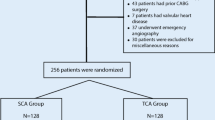Abstract
The aim of this study was to evaluate radiation dose and patient discomfort/pain in radial artery access vs femoral artery access in percutaneous coronary intervention (PCI). Dose–area product (DAP) was measured non-randomised for 114 procedures using femoral access and for 55 using radial access. The patients also responded to a questionnaire concerning discomfort and pain during and after the procedure. The mean DAP was 69.8 Gy cm2 using femoral access and 70.5 Gy cm2 using radial access. Separating the access site from confounding factors with a multiple regression, there was a 13% reduction in DAP when using radial access (p=0.038). Procedure times did not differ (p=0.81). Bed confinement was much longer in the femoral access group (448 vs 76 min, p=0.000). With femoral access, there was a significantly higher patient grading for chest (p=0.001) and back pain (p=0.003) during the procedure and for access site (p=0.000) and back pain (p=0.000) after the procedure. Thirty-two femoral access patients (28%) were given morphine-type analgesics in the post-procedure period compared to three radial access patients (5%, p=0.001). DAP does not increase when using radial instead of femoral access and the patients grade discomfort and pain much lower when using radial access. Radial access is thus beneficial to use.


Similar content being viewed by others
References
Fransson S-G, Nylander E (1994) Vascular injury following cardiac catheterization, coronary angiography, and coronary angioplasty. Eur Heart J 15:232–235
Campeau L (1989) Percutaneous radial artery approach for coronary angiography. Catheter Cardiovasc Diagn 16:3–7
Kiemeneij F, Laarman GJ (1993) Percutaneous transradial artery approach for coronary stent implantation. Catheter Cardiovasc Diagn 30:173–178
Cooper CJ, El-Shiekh RA, Cohen DJ, Blaesing L, Burket MW, Basu A, Moore JA (1999) Effect of transradial access on quality of life and cost of cardiac catheterization: a randomized comparison. Am Heart J 138:430–436
Mann JT, Cubeddu G, Arrowood M (1996) Operator radiation exposure in PTCA: comparison of radial and femoral approaches. J Invasive Cardiol 8(Suppl D):22D–25D
Sandborg M, Fransson SG, Pettersson H (2004) Evaluation of patient-absorbed doses during coronary angiography and intervention by femoral and radial artery access. Eur Radiol 14:653–658
Pipilis A, Ormerod O, Tan LB (1990) Operator radiation exposure and cardiac catheterisation route. Lancet 336:567–568
Ugarte M, Martin-Judez V (1992) Radiation exposure after coronary arteriography. Lancet 340:923
ICRP (2000) Avoidance of radiation injuries from medical interventional procedures. ICRP Publication 85. Pergamon, Oxford
Geijer H, Beckman K-W, Andersson T, Persliden J (2002) Radiation dose optimization in coronary angiography and percutaneous coronary intervention (PCI). II. Clinical evaluation. Eur Radiol 12:2813–2819
Geijer H, Beckman K-W, Andersson T, Persliden J (2002) Radiation dose optimization in coronary angiography and percutaneous coronary intervention (PCI). I. Experimental studies. Eur Radiol 12:2571–2581
McConnell EA (1997) Performing Allen’s test. Nursing (Brux) 27:26
Altman DG (1991) Practical statistics for medical research. Chapman & Hall, London
Martin CJ, Farquhar F, Stockdale E, MacDonald S (1994) A study of the relationship between patient dose and size in paediatric radiology. Br J Radiol 67:864–871
Kiemeneij F, Laarman GJ, Odekerken D, Slagboom T, van der Wieken R (1997) A randomized comparison of percutaneous transluminal coronary angioplasty by the radial, brachial and femoral approaches: the Access study. J Am Coll Cardiol 29:1269–1275
Stella PR, Kiemeneij F, Laarman GJ, Odekerken D, Slagboom T, van der Wieken R (1997) Incidence and outcome of radial artery occlusion following transradial artery coronary angioplasty. Catheter Cardiovasc Diagn 40:156–158
Louvard Y, Lefevre T, Allain A, Morice M (2001) Coronary angiography through the radial or the femoral approach: The CARAFE study. Catheter Cardiovasc Interv 52:181–187
Larrazet F, Dibie A, Philippe F, Palau R, Klausz R, Laborde F (2003) Factors influencing fluoroscopy time and dose-area product values during ad hoc one-vessel percutaneous coronary angioplasty. Br J Radiol 76:473–477
Neofotistou V, Vano E, Padovani R, Kotre J, Dowling A, Toivonen M, Kottou S, Tsapaki V, Willis S, Bernardi G, Faulkner K (2003) Preliminary reference levels in interventional cardiology. Eur Radiol 13:2259–2263
Hildick-Smith DJ, Walsh JT, Lowe MD, Petch MC (2003) Coronary angiography in the fully anticoagulated patient: the transradial route is successful and safe. Catheter Cardiovasc Interv 58:8–10
Caputo RP, Simons A, Giambartolomei A, Grant W, Fedele K, Abraham S, Felice P, Reger MJ, Walford GD, Esente P (2001) Safety and efficacy of repeat transradial access for cardiac catheterization procedures. Catheter Cardiovasc Interv 54:188–190
Louvard Y, Krol M, Pezzano M, Sheers L, Piechaud JF, Marien C, Benaim R, Lardoux H, Morice MC (1999) Feasibility of routine transradial coronary angiography: a single operator’s experience. J Invasive Cardiol 11:543–548
Koreny M, Riedmüller E, Nikfardjam M, Siostrzonek P, Müllner M (2004) Arterial puncture closing devices compared with standard manual compression after cardiac catheterization: systematic review and meta-analysis. J Am Med Assoc 291:350–357
Keeling AW, Fisher CA, Haugh KH, Powers ER, Turner MS (2000) Reducing time in bed after percutaneous transluminal coronary angioplasty (TIBS III). Am J Crit Care 9:185–187
Acknowledgements
We thank Karin Jonsson RN for interviewing the patients after the procedure. We are also grateful to all radiologists, cardiologists and nurses at the section for thoracic radiology for their co-operation and collection of patient dose values. We also thank Anders Magnuson for statistical assistance.
Author information
Authors and Affiliations
Corresponding author
Rights and permissions
About this article
Cite this article
Geijer, H., Persliden, J. Radiation exposure and patient experience during percutaneous coronary intervention using radial and femoral artery access. Eur Radiol 14, 1674–1680 (2004). https://doi.org/10.1007/s00330-004-2322-4
Received:
Revised:
Accepted:
Published:
Issue Date:
DOI: https://doi.org/10.1007/s00330-004-2322-4




